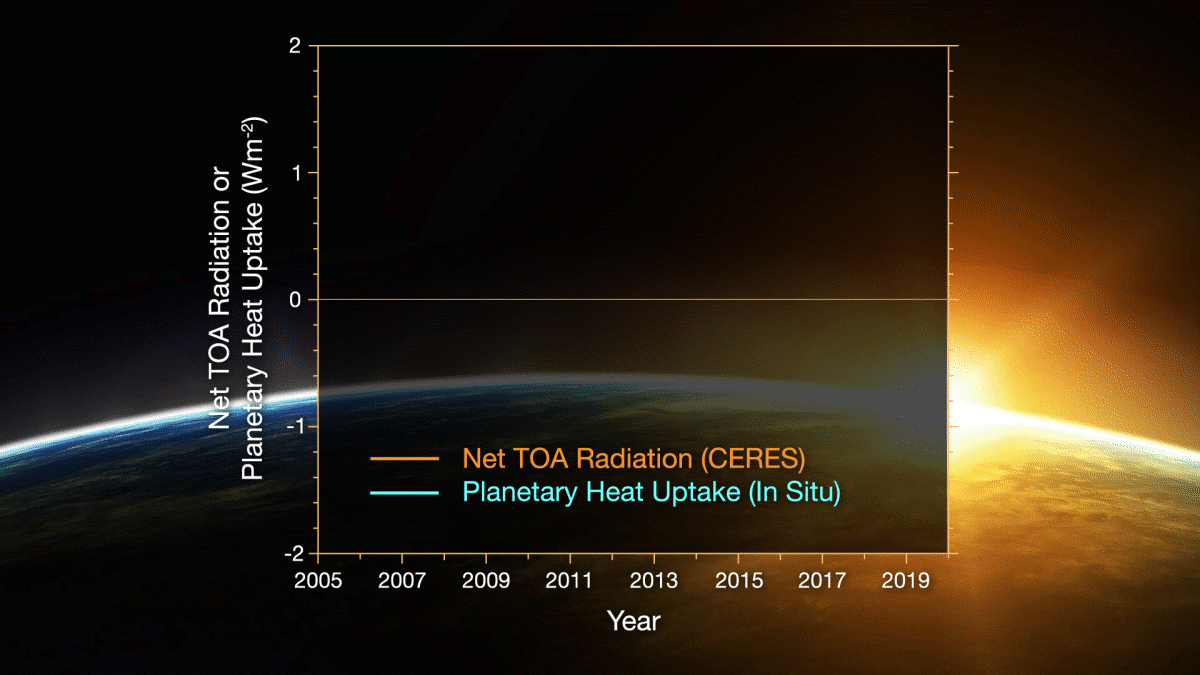At the current rate of heat uptake, greater changes in climate than are already occurring should be expected, a new study finds.
15 June 2021

Sunrise lights Earth’s atmosphere, seen from the International Space Station.
Credit:NASA
AGU press contact:
Liza Lester, +1 (202) 777-7494, [email protected] (UTC-4 hours)
NASA press contact
Joe Atkinson, +1 (757) 755-5375, [email protected] (UTC-4 hours)
NOAA press contact
Theo Stein, +1 (303) 819-7409, [email protected] (UTC-6 hours)
Contact information for the researchers:
Norman Loeb, NASA Langley Research Center, Virginia, [email protected] (UTC-4 hours)
Gregory Johnson, NOAA Pacific Marine Environmental Laboratory in Seattle, Washington, [email protected] (UTC-7 hours)
WASHINGTON— Researchers have found that Earth’s energy imbalance approximately doubled during the 14-year period from 2005 to 2019.
Earth’s climate is determined by a delicate balance between how much of the Sun’s radiative energy is absorbed in the atmosphere and at the surface and how much thermal infrared radiation Earth emits to space. A positive energy imbalance means the Earth system is gaining energy, causing the planet to heat up.
The doubling of the energy imbalance is the topic of a new study published today in Geophysical Research Letters, AGU’s journal for high-impact, short-format reports with immediate implications spanning all Earth and space sciences.

Rising heat retention: Comparison of overlapping one-year estimates at 6-month intervals of net top-of-the-atmosphere annual energy flux from CERES (solid orange line) and an in situ observational estimate of uptake of energy by Earth climate system (solid turquoise line).
Credit: NASA/Tim Marvel
Scientists at NASA and NOAA compared data from two independent measurements. NASA’s Clouds and the Earth’s Radiant Energy System (CERES) suite of satellite sensors measure how much energy enters and leaves Earth’s system. In addition, data from a global array of ocean floats, called Argo, enable an accurate estimate of the rate at which the world’s oceans are heating up. Since approximately 90 percent of the excess energy from an energy imbalance ends up in the ocean, the overall trends of incoming and outgoing radiation should broadly agree with changes in ocean heat content.
“The two very independent ways of looking at changes in Earth’s energy imbalance are in really, really good agreement, and they’re both showing this very large trend, which gives us a lot of confidence that what we’re seeing is a real phenomenon and not just an instrumental artifact, ” said Norman Loeb, lead author for the new study and principal investigator for CERES at NASA’s Langley Research Center in Hampton, Virginia. “The trends we found were quite alarming in a sense.”
Off balance
Greenhouse gases such as carbon dioxide and methane trap heat in the atmosphere, capturing outgoing radiation that would otherwise escape into space. Emissions of these gases are increasing due to human activity. The warming drives other changes, such as snow and ice melt, and increased water vapor and cloud changes that can further enhance the warming.
Earth’s energy imbalance is the net effect of all these factors. In order to determine the primary factors driving the imbalance, the investigators used a method that looked at changes in clouds, water vapor, combined contributions from trace gases and the output of light from the Sun, surface albedo (the amount of light reflected by the Earth’s surface), tiny atmospheric particles called aerosols, and changes in surface and atmospheric temperature distributions.
The study finds the doubling of the imbalance is partially the result of decreased clouds and sea ice that lead to more absorption of solar energy. Additionally, an increase in greenhouse gases due to human activity, also known as anthropogenic forcing, along with increases in water vapor are trapping more outgoing longwave radiation, further contributing to Earth’s energy imbalance.
The researchers also found a flip of the Pacific Decadal Oscillation (PDO) from a cool phase to a warm phase likely played a major role in the intensification of the energy imbalance.
The Pacific Decadal Oscillation is a pattern of Pacific climate variability. Its fingerprint includes a massive wedge of water in the eastern Pacific Ocean that goes through cool and warm phases. This naturally occurring internal variability in the Earth system can have far-reaching effects on weather and climate. An intensely warm Pacific Decadal Oscillation phase that began around 2014 and continued until 2020 caused a widespread reduction in cloud coverage over the ocean and a corresponding increase in the absorption of solar radiation.
“It’s likely a mix of anthropogenic forcing and internal variability,” said Loeb. “And over this period they’re both causing warming, which leads to a fairly large change in Earth’s energy imbalance. The magnitude of the increase is unprecedented in this record.”
Loeb cautions that the study is only a snapshot relative to long-term climate change, and that it’s not possible to predict with any certainty what the coming decades might look like for the balance of Earth’s energy budget. The study does conclude, however, that unless the rate of heat uptake subsides, greater changes in climate than are already occurring should be expected.
“The lengthening and highly complementary records from Argo and CERES have allowed us both to pin down Earth’s energy imbalance with increasing accuracy, and to study its variations and trends with increasing insight, as time goes on.” said Gregory Johnson, a co-author on the new study and physical oceanographer at the National Oceanic and Atmospheric Administration’s Pacific Marine Environmental Laboratory in Seattle, Washington. “Observing the magnitude and variations of this energy imbalance are vital to understanding Earth’s changing climate.”
###
AGU (www.agu.org) supports 130,000 enthusiasts to experts worldwide in Earth and space sciences. Through broad and inclusive partnerships, we advance discovery and solution science that accelerate knowledge and create solutions that are ethical, unbiased and respectful of communities and their values. Our programs include serving as a scholarly publisher, convening virtual and in-person events and providing career support. We live our values in everything we do, such as our net zero energy renovated building in Washington, D.C. and our Ethics and Equity Center, which fosters a diverse and inclusive geoscience community to ensure responsible conduct.
Notes for Journalists:
This research study will be freely available for 30 days. Download a PDF copy of the paper here. Neither the paper nor this press release is under embargo.
Paper title:
“Satellite and Ocean Data Reveal Marked Increase in Earth’s Heating Rate”
Authors:
- Norman G. Loeb: NASA Langley Research Center, Hampton, VA, USA;
- Gregory C. Johnson: NOAA/Pacific Marine Environmental Laboratory, Seattle, WA, USA;
- Tyler J. Thorsen: NASA Langley Research Center, Hampton, VA, USA;
- John M. Lyman: NOAA/Pacific Marine Environmental Laboratory, Seattle, WA, USA, and Joint Institute for Marine and Atmospheric Research, University of Hawaii at Manoa, Honolulu, HI, USA;
- Fred G. Rose: Science Systems and Applications, Inc., Hampton, VA, USA;
- Seiji Kato: NASA Langley Research Center, Hampton, VA, USA.